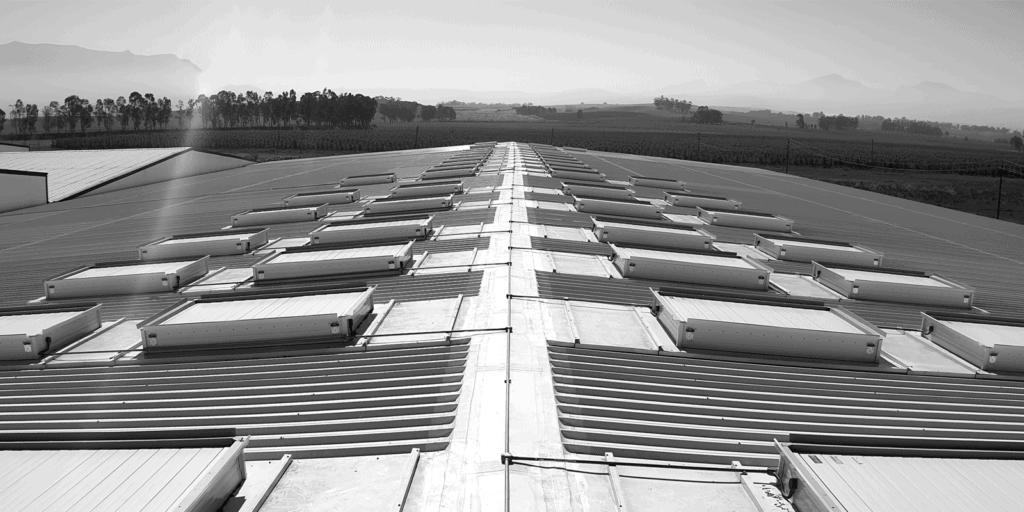Introduction
Smoke control systems are indispensable for preserving safety within buildings, particularly during fire incidents. In the South African context, the guideline for smoke ventilation systems is provided by SANS 10400 Part T, while on a broader European scale, EN12101 sets the standards. This article delves into 15 critical queries surrounding smoke control, aiming to enlighten architects, engineers, and property owners on this vital safety aspect.
Q&A’s About Smoke Control
Fire curtains must possess a specified fire resistance rating to endure the heat and flames of a fire for a designated period. This rating, typically expressed in minutes (e.g., 60, 90, or 120 minutes), hinges on the building’s occupancy and use.
1. Understanding SANS 10400 Part T in Smoke Control
SANS 10400 Part T, a directive from the South African National Standards, delineates the criteria for managing smoke and heat within edifices. It’s pivotal for averting smoke accumulation, which is lethal in fire scenarios.
2. The Relevance of EN12101 to South African Smoke Control
Although not a requisite in South Africa, EN12101, a European norm, lays down the specifications for smoke control apparatuses, serving as a recognized yardstick for smoke control mechanisms.
3. Mandatory Instances for Smoke Control Systems
Predominantly, smoke control systems are obligatory in skyscrapers, vast assembly venues, and structures with intricate escape routes. Adherence is dictated by the edifice’s dimensions, the nature of occupancy, and regional regulations.
4. Key Constituents of a Smoke Control System
The backbone of a smoke control system encompasses smoke detectors, control panels, automatic opening vents (AOVs) or Smoke Ventilators, and mechanical smoke extraction mechanisms. These integral units collaborate to detect, manage, and expel smoke.
5. The Significance of Automatic Opening Vents (AOVs)
AOVs or smoke ventilators are engineered to autonomously open upon the detection of smoke or triggering of fire alarms, facilitating the efficient expulsion of smoke, and safeguarding inhabitants.
6. Maintenance Frequency for Smoke Control Systems
Periodic examination and upkeep are vital to preserving the reliability of smoke control systems. A common practice is to have these systems inspected and tested bi-annually.
7. Utilising Natural Ventilation for Smoke Control
Yes, manual windows and other natural ventilation strategies can be employed for smoke control, provided they conform to the requisite standards.
8. Smoke Control Design Considerations in Atriums
Atriums, with their unique architectural features, necessitate careful smoke control design to avert smoke propagation and ensure safe evacuation.
9. Fire Resistance Criteria for Smoke Control Dampers
The fire resistance rating, typically denoted in minutes like 60, 90, or 120, is crucial for smoke control dampers, reflecting the building’s fire safety requirements.
10. Integration of Smoke Control Systems with Building Management Systems (BMS)
Yes, amalgamating smoke control systems with BMS augments building safety and efficiency through real-time monitoring and control.
11. Fire Curtains in Smoke Control
Fire curtains play a pivotal role in smoke control systems by containing smoke and fire within specified zones, thwarting their spread across the building.
12. Legal Mandates for Building Owners Regarding Smoke Control Systems
Building proprietors are legally bound to ensure the installation, testing, and maintenance of smoke control systems in line with pertinent regulations and standards.
13. Selecting Apt Smoke Control Equipment
The choice of smoke control equipment should resonate with the building’s specific demands, considering factors like occupancy type, building dimensions, and regional regulations.
14. Retrofitting Existing Buildings with Smoke Control Systems
Yes, current structures can be retrofitted with smoke control systems to enhance safety and align with contemporary regulations.
15. Staying Abreast of Smoke Control Standards and Regulations
To keep updated, regular consultations with local authorities, industry experts, and relevant publications are advisable. Participating in seminars and training sessions is also beneficial.
Conclusion
With a deeper understanding of the regulations encapsulated in SANS 10400 Part T and EN12101, stakeholders are well-equipped to make informed decisions regarding the design, implementation, and maintenance of smoke control systems, thereby significantly enhancing fire safety and minimizing risks.



